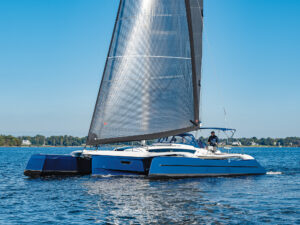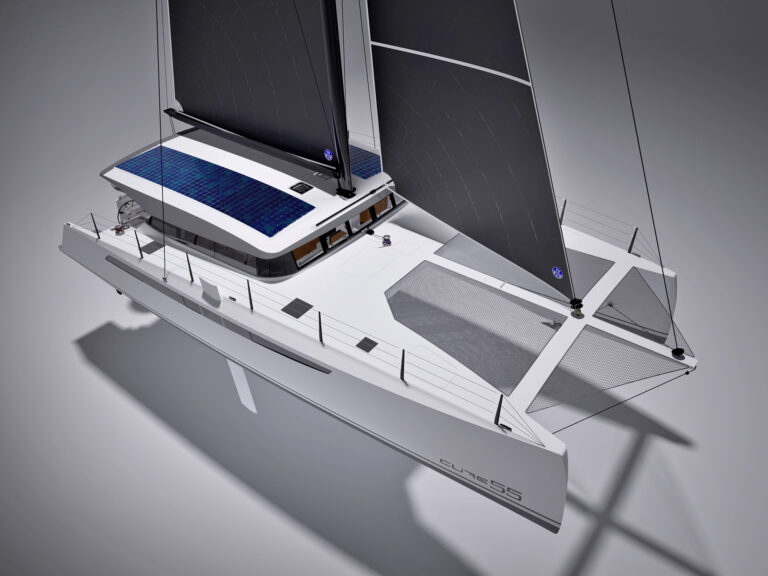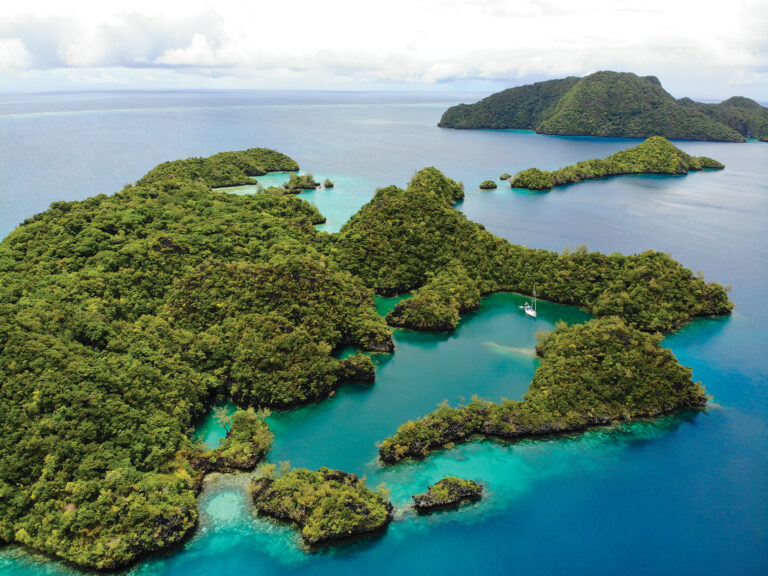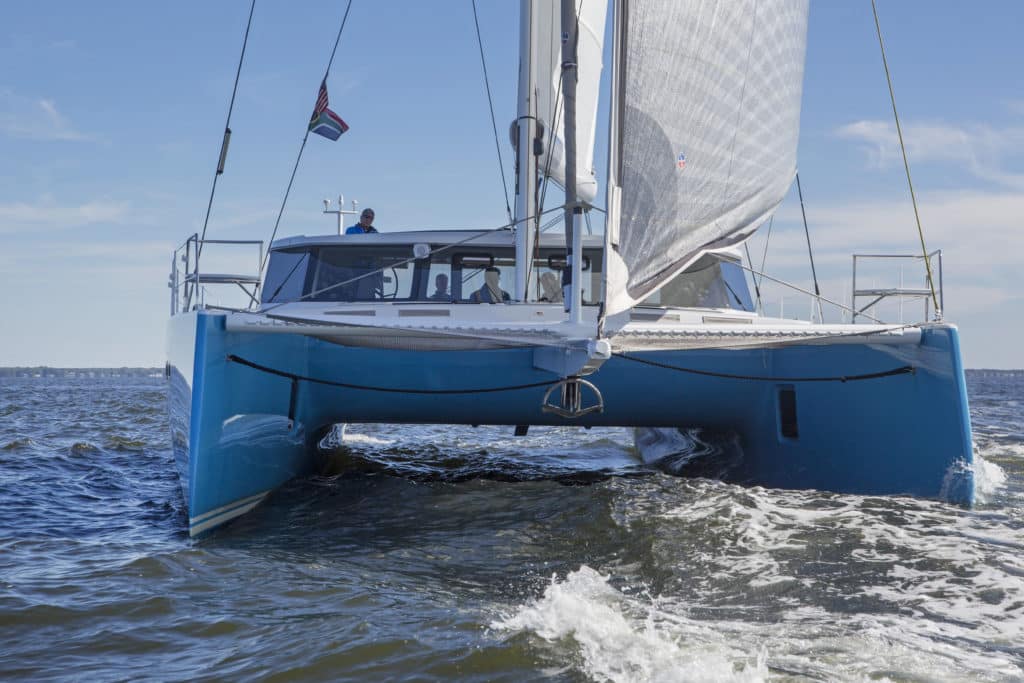
Winner: Balance 526
When it comes to cruising catamarans, there are two nations above all others that have become the world leaders in the design and construction of new models: France and South Africa. Yet in a still-surprising twist, in the Full-Size Multihull Over 50 Feet category in the 2017 BOTY contest, all four nominees — the Balance 526, Royal Cape Catamarans Majestic 530, St. Francis 50 MK II and Xquisite X5 — were South African products. Perhaps not so surprisingly, they represented the strongest division in the entire fleet.
The most unusual cat in the quartet was the Majestic 530, built in Durban and originally designed as a 40-footer, but one that over time evolved into ever-larger siblings, including 42-, 45-, 50- and finally 53-foot versions. The company billed the boat as “safe, stable, [and set up for] singlehanded sailing with superior specifications and long-range capabilities.” For the most part, the judging panel agreed with this summation.
“They had stainless-steel handholds all the way around the perimeter of the yacht — better handholds than all the other cats, probably,” said Carol Hasse, always mindful of the safety features among the nominees. “The layout of the deck and cabin top was very functional. And there was good nonskid throughout.”
“The model we sailed had five cabins and five heads,” noted Tim Murphy, while acknowledging that other layouts were available. “The fit and finish of the interior was very good. As you’re living in those cabins, it’s clear that a lot of man-hours went into their execution.”
Some members of the panel were familiar with the St. Francis 50 MK II; an earlier iteration of the Angelo Lavranos design was named the Best Cruising Multihull in 2006. Murphy was effusive in his praise for company founder and owner Duncan Lethbridge. “He’s kind of the godfather of South African catamaran boatbuilding,” he said. “He’s definitely a legend. His firm builds four boats a year, so it’s not a high-output yard. But they’ve made some interesting innovations with this boat along the way. Lethbridge was one of the first catamaran builders to start infusing hulls, which he did with the MK II version. And the boat really sails well. We were sailing in about 7 to 8 knots of true wind and still making nearly 7 knots. Lethbridge said the boat would sail the same speed as the breeze in up to 10 knots of wind, and after sailing the boat, I believe him.”
“There’s a lot to like about this boat,” seconded Hasse. “The cockpit lockers are arranged so you can fit in five scuba tanks. There’s a paddleboard storage locker in the aft coaming, and a really nice swim ladder. They didn’t lead all the running rigging aft, like so many cats. You could actually deal with things at the mast — there’s a winch, rope clutches, mast steps, handholds — that I prefer to deal with there, like the spinnaker halyard. Compared to some of the other cats, I found this very seaworthy.”
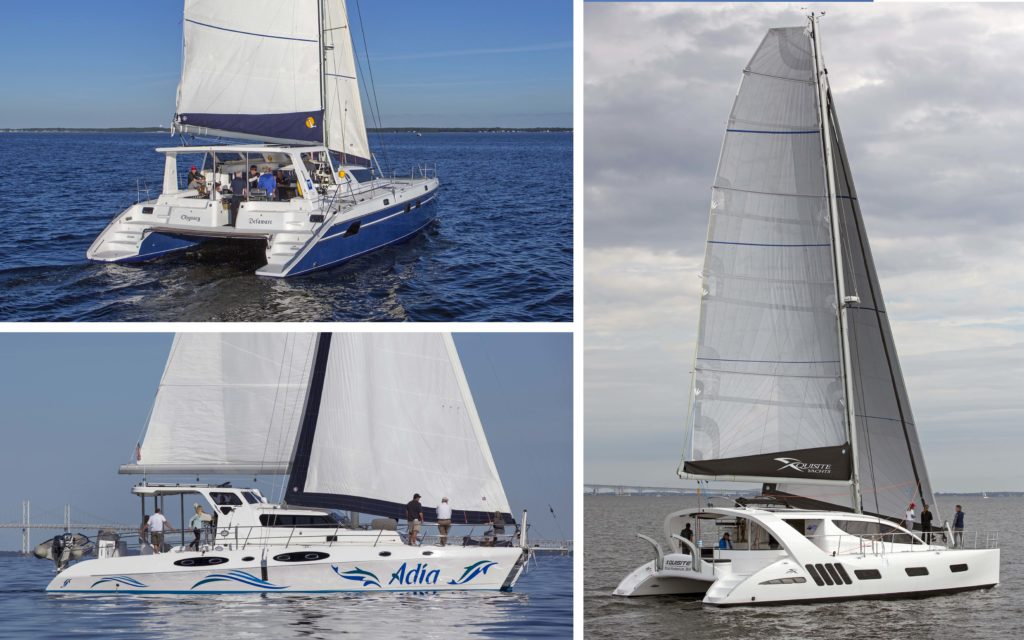
“Systemswise, it has some pretty neat engineering,” said Ed Sherman. “And they did a really nice job creating laminates for all the cabinetry. There was a high degree of workmanship visible that we didn’t see with all the nominees.” Next was the Xquisite X5. The cat did not win this category, but it proved to be an award-winning design just the same. “It’s a little bit of a strange-looking boat,” said Murphy. “Sailing blogger Charles Doane wrote that it’s the boat that looks the most like a running shoe, and I think that’s sort of accurate.”
Yet there is beauty in utility and comfort, as Murphy discovered when he stepped aboard. “It’s lovelier on board than it is at a distance,” he said. “When you’re in the space in the main saloon or down in the hulls, it’s really nice. They’ve created volume in the hulls for all the berths to be fore-and-aft; they didn’t make the concession to performance and speed that, for instance, the Balance 526 did. The Balance designers chose hull forms that would deliver particular speeds and then developed the interior around those forms. The Xquisite is the other way around, I think. There’s just detail after detail after detail. The number of seagoing details that are built into this boat is really, really impressive.”
The remaining boat in the running was the aforementioned Balance 526. Murphy expanded on his previous thoughts about the cat: “I think this is a performance cat that a couple can sail well. There are many details I like about it. One of them is that there are no gimmicks or quirks about the hull form — no bumps or chines. The builder decided from the beginning that he wanted a boat that can consistently sail between 10 and 12 knots. To do that, you have to have a hull form that wasn’t going to get too voluminous or too splashy in different kinds of seaways, and stay true to it.
“There are compromises in it,” he continued. “It means you can’t have the spacious island queen berths facing fore-and-aft like many other cats do. But I think that’s an honest and honorable choice. Not everybody’s going to love it, but it started with the hull form and then went to the interior, and I’m very glad that the choice exists in the marketplace. I think the hulls are beautiful. Under sail, we sat on the forward trampolines and just watched the boat moving through the water, and it was really lovely.”
Murphy’s colleagues agreed. Not only did the Balance 526 take the Import Boat of the Year award, but it also walked away with the title of Best Full-Size Multihull Over 50 Feet for 2017. Clearly, a boat with two hulls this pretty deserved not one but a pair of prizes.
Click here to find out the winners of the 2017 Best Full-Size Multihull Under 50 Feet.


